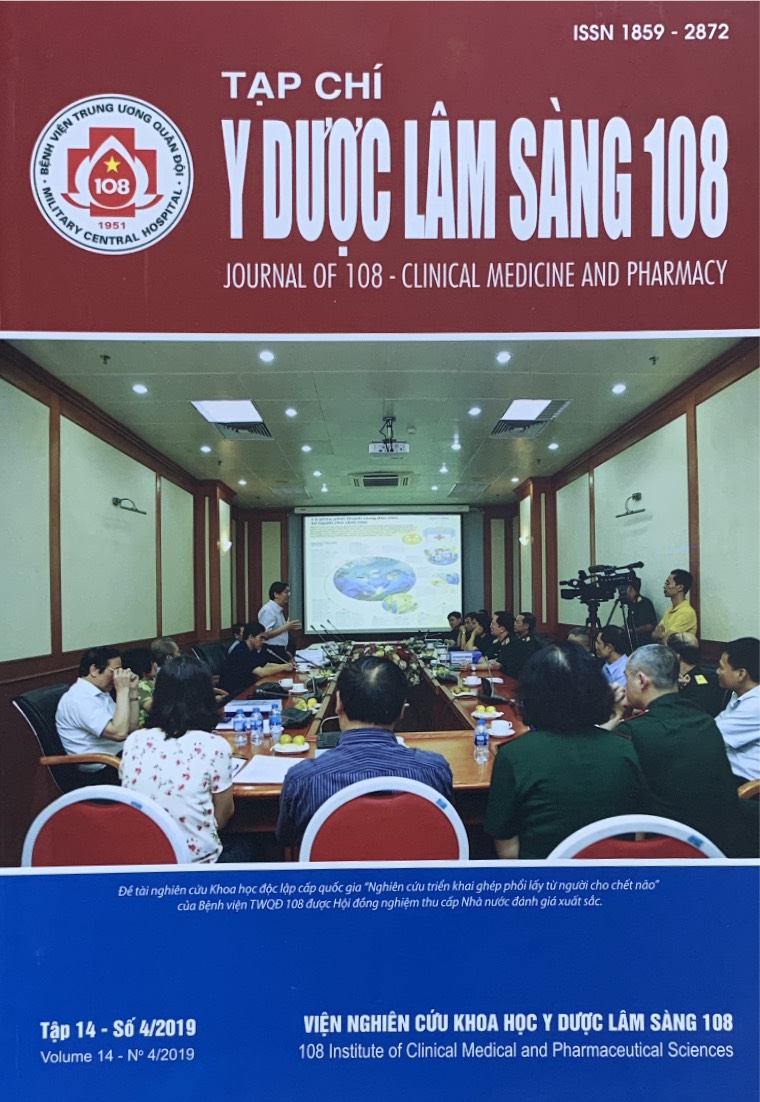Kết quả sinh thiết huyết khối tĩnh mạch cửa ở bệnh nhân ung thư biểu mô tế bào gan giai đoạn tiến triển
Main Article Content
Keywords
Tóm tắt
Mục tiêu: Đánh giá kết quả bước đầu và độ an toàn của sinh thiết huyết khối tĩnh mạch cửa qua da dưới hướng dẫn của siêu âm. Đối tượng và phương pháp: Nghiên cứu tiến cứu, mô tả cắt ngang, 101 bệnh nhân ung thư biểu mô tế bào gan có huyết khối tĩnh mạch cửa được sinh thiết huyết khối qua da dưới hướng dẫn của siêu âm bằng súng Fast gun. Kết quả: Kỹ thuật thành công trên cả 101 bệnh nhân (cả 101 mẫu bệnh phẩm đủ chẩn đoán mô bệnh), không có biến chứng nào xảy ra, cảm giác khó chịu và đau nhẹ tương tự như trong sinh thiết u gan lần trước. Cả 101 mẫu bệnh phẩm đều có tế bào gan ác tính trong tổn thương huyết khối. Độ biệt hóa vừa chiếm tỷ lệ cao nhất 57,4%, biệt hóa thấp 33,7%, biệt hóa cao chiếm tỷ lệ 8,9%. Kết luận: Tất cả 101 bệnh nhân được sinh thiết trong nghiên cứu đều cho thấy kết quả huyết khối tĩnh mạch cửa đều là tổ chức ung thư. Sinh thiết huyết khối tĩnh mạch cửa qua da dưới hướng dẫn của siêu âm là kỹ thuật an toàn, tin cậy.
Article Details
Các tài liệu tham khảo
2. Bộ Y tế Việt Nam (2012) Hướng dẫn chẩn đoán và điều trị ung thư tế bào gan nguyên phát. Quyết định số 5250/QĐ-BYT.
3. Floridi C et al (2017) Yttrium-90 radioembolization treatment for unresectable hepatocellular carcinoma: A single-centre prognostic factors analysis. Medical Oncology 34(10): 174.
4. Erwin Kuntz and Hans-Dieter Kuntz (2006) Hepatology, principles and practice: History, morphology, biochemistry, diagnostics, clinic, therapy. Springer Science & Business Media.
5. Gerald DD, Brian IC (1993) Percuatneous biopsy of portal vein thrombus: A New staging technique for hepatocellular carcinoma. AJR 161: 229-233.
6. Gregory CC, Rui C, Ollivier H et al (2008) Incidence, risk factors and consequences of portal vein and systemic thromboses in hepatocellular carcinoma. Thromb Res 122(3): 299-306.
7. Jie S, Eric CH Lai, Nam L et al (2011) A new classification for hepatocellular carcinoma with portal vein tumor thrombus. J Hepatobiliary Pancreat Sci 18: 74-80.
8. Katsuaki T et al (1993) Diagnosis of portal vein thrombosis in patients with hepatocellular carcinoma: Efficacy of color Doppler sonography compared with angiography. AJR 160: 1279-1283.
9. Masamichi K (2002) Pathological evolution of early Hepato-cellular carcinoma. Oncology 62(1): 43-47.
10. Tublin ME, Dodd GD, Baron RL (1997) Benign and malignant portal vein thrombosis: Differentiation by CT characteristics. AJR; 168:719-723.
11. Nishant P, Boris A, Zili H et al (2010) Hepatocellular carcinoma presenting as an incidental isolated malignant portal vein thrombosis. J Gastrointest Canc, DOI 10.1007/s12029-010-9235z (Abstract on Pubmed).
12. Pasiri S, Teerha P, Wiwatana T, Nualta A, Surat T (2000) Review of 336 patients with hepatocellular carcinoma at Songklanagarynd Hospital. World J Gastroentero 6(3): 339-343.
13. Tenzin N, Prashant P et al (2011) Portal vein thrombosis-clinical profile. JIACM 12(2): 134-140.
 ISSN: 1859 - 2872
ISSN: 1859 - 2872
